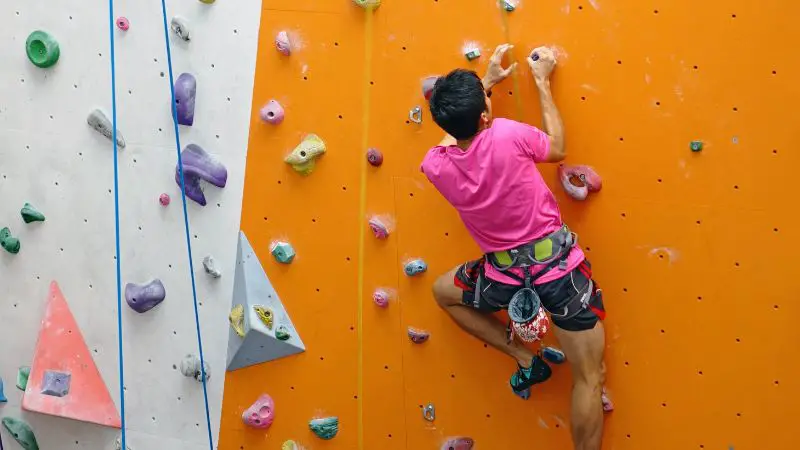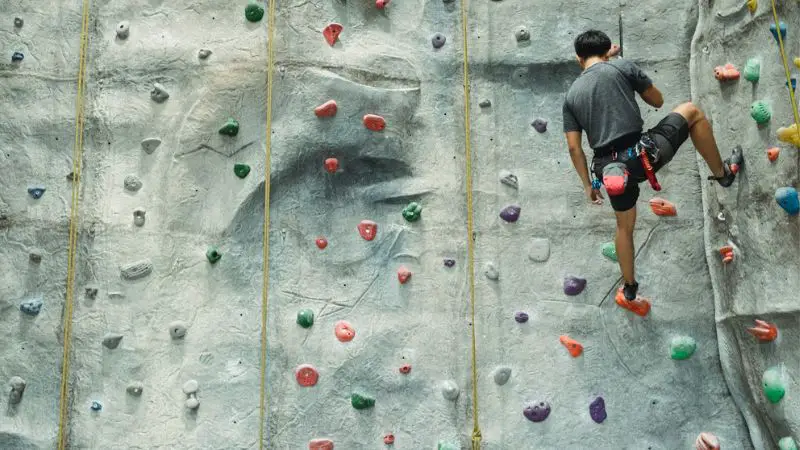What muscles does climbing work?
Climbing is fast becoming a sports cum adventure activity which is really great for your fitness goals.
Being fit and healthy requires workouts and exercise whether be it in the gym or outdoor!
But often many people ask how climbing improves health and overall strength!
Many people struggle with this issue and question how good or effective climbing is for your fitness goals.
This article is perfect if you are a beginner and want to know all about climbing and the muscles it targets, its effects and all.
So, let’s jump right into…
Can climbing build muscle and replace weight training?

Climbing is a type of exercise that can help build muscle and replace weight training moreover the muscles used in climbing are the same muscles that are used in weight training.
It also provides an aerobic workout, which is a cardio workout.
Climbing is a high-intensity, full-body workout and involves the entire body, but the muscles in your arms often get the most out of it.
This exercise also increases stamina, agility, and coordination.
One can say that it is not only a great way to build muscle, but it also releases endorphins which make you feel good.
You can also see it as a replacement for weight training because it builds muscle and increases your heart rate.
A highly effective form of physical activity, that not only can build muscle, it’s also a load-bearing form of training.
So, climbing can offer the same physical benefits of weight training while also getting rid of the negatives like static forces and repetitive motions.
A few years ago, climbing wasn’t that popular as a workout type but with time, this became one of those things people are opting to do in their free time not just to stay fit but because they enjoy doing it.
More climbers can be seen in gyms nowadays which is inspiring many onlookers to go for climbs or take up a rock or ice climbing as a new hobby and fitness goal.
However, judging by the range of muscle that is being used while climbing, I would say that it’s definitely a better thing to do than weight training on its own.
For such things as toning, you are absolutely not going to get the same level of benefits from climbing as you would from weight training.
What muscles are used in climbing?
Climbing demands the use of many major muscle groups, including the hamstrings, quadriceps, levator scapulae, and serratus anterior.
It engages one’s back muscles by causing them to support the weight in various ways.
So, what muscles does climbing work?
The target muscles used in climbing vary entirely on what type of climb you are doing as well as how difficult it is.
- The primary muscles used in climbing are Lats and Back, Lats muscles are primarily located below the shoulder blade on both sides.
- This is the muscle group that helps you to lift your entire body weight against gravity and help you go back & forth.
- Some small muscle fibers are used during climbs when you have to hold on and wait for your next route to turn its face and these include muscles such as the biceps brachii muscle.
- A number of different muscles form part of the climbing movement.
- The muscular exertion increases gradually, as it requires more and more strength for certain weather conditions and altitudes.
Climbing is a physical activity of ascending steep gradients, usually using one’s hands, feet, or both.
All the climbing movements are made up of muscular exertion that increases gradually.
And they use back and arm muscles for these movements.
Climbing not only requires endurance but also involves significant grip strength, strength balance, and coordination of both hands.
Is climbing better than a gym?

In recent times, there’s always been a debate going on whether climbing or a gym workout is better!
Are you tired of countless gym sessions and not seeing any results? Learn if climbing is a better option for you or not!
Although it also boils down to what are your needs and what are you looking to gain from these exercises!
Climbing is a sport that requires physical strength and skill and it is also done on-site by various businesses, and on-site at gyms in many places.
Bouldering, canyoning, and paragliding are but a few of the destinations people would pay money to visit one day a week if they are closer to their homes.
It also does not require equipment, just your muscular strength, and endurance.
And is considered a total body exercise and also improves mental state as cycling does.
On the other hand weight training is a strength-building exercise that helps you build muscle and lead forward to dips.
There are some other benefits of climbing but one unique benefit outweighs the others: being outdoors!
Climbing targets all the muscles in the body at once without any single muscle getting overworked.
This makes climbing ideal for an individual who wants to get fitter, healthier, and challenge themselves simultaneously.
Does climbing make you stronger?
Any type of climbing exercise or sport whether you are in the gym or outdoor will make your muscles strong and improves physical strength.
Climbing requires strength, perseverance, and determination and It’s also a sport that can give you all of those qualities.
It will make you stronger, but it will help you build up your muscles and improve your endurance.
Practicing climbing requires intense physical strength and it helps to develop upper body and arm strength.
How does climbing make you strong forever?
- This exercise helps to improve your mental health and provides an outlet from stress and anxiety to let you find focus or simply reduce your anxiety and depression when you practice it.
- Moreover, in addition to teaching many practical skills, climbing helps people strengthen their mental fortitude and cope with adversity.
If your goal is to increase strength then climbing is perfect for it, but if you want to build muscle you also need weight training.
What are the Benefits of Climbing?
One of the most popular sports that are dependent on your hands and feet to ascend a rock wall.
The goal of climbing is to get to the top of the wall without falling and it has many benefits, including improving balance, agility, and strength.
Climbing is an intense workout and demands real stamina and upper body strength.
Still, confused about what muscles does climbing work? here are some benefits of climbing.
The benefits of climbing are many –
- It can improve agility, reflexes, balance, and coordination.
- Also improves your mental health by providing a sense of accomplishment and achievement.
- Climbing also has the added bonus of being a low-impact activity that strengthens the muscles in your arms, legs, shoulders, and back without causing any strain on your joints or bones.
Rock climbing workouts are an excellent way for beginners to start climbing because they can be done almost anywhere.
You can try these activities with minimum equipment at home or in the gym.
Many climbing exercises for beginners are perfect for those who want to start climbing but don’t know where to begin.
Any able-bodied person looking for an effective workout can do this activity that will improve their health and fitness levels.
Muscles not used in climbing
Although climbing does not use so many muscles as running.
The least used muscles for climbing are those in the lower body which rely heavily on grip related to grabbing motions like fingers clutching an object or rope.
When you are climbing its works your forearms, quads, back, abs, and upper back muscles.
Whereas the most neglected muscles are legs, triceps, pectorals, and hand extensors.
Muscles used in climbing a ladder or stairs
When you are climbing a ladder or stairs, that’s automatically the best workout for your muscles.
It is also quite important for your health in maintaining a fit body.
The muscles used in climbing different types of stairs or ladders will differ depending on the type you are climbing.
And climbing a ladder is different than climbing stairs.
One obvious difference is that climbing a ladder requires more upper body strength while climbing stairs requires greater lower body strength.
Climbing a ladder mostly necessarily involves using latissimus dorsi and biceps.
Meanwhile, when you climb stairs you tend to use the gluteus maximus for the ascent phase.
The muscles used in climbing a ladder or stairs are the arms, chest, stomach, and thighs.
If you are climbing a ladder or stairs, it will require load-bearing muscles, extremity muscles, gripping muscles, and holding muscles.
These activities also activate your legs muscles especially core muscles like glutes, calves, hamstrings, and quads.
Exercise like Lunges & squats also target the same above leg muscles, so if you don’t like lunges and squats, try climbing stairs.
Can rock climbing get you ripped?
Rock climbing is a great way to get in shape and build muscle, it is an excellent form of exercise that can help you get ripped.
You can use it as a cardiovascular exercise or as a weight-bearing activity for muscle building and you can use it to train for other sports, like running or cycling.
A great way to work out your mental health and keep your mind sharp, rock climbers are constantly solving puzzles and problems.
It’s a great cardiovascular, stamina, endurance, and strength-building exercise, but you can’t get ripped by rock climbing only!
Including weight training and other physical workouts helps in building strong muscles and getting ripped.
Your back and triceps strength increase gradually due to pulling and positioning your body while climbing.
What muscles do rock climbing work
Your hands and upper body muscles get a ton of workouts when you go fo rock climbing.
Easily one of the best total body-workout exercises and these days it’s possible to try it in the gym.
In order to lift your body while climbing, you use leg muscles and also glute power.
Lats, trapezium, and rhomboid muscles help to keep core muscles stable while rock climbing.
It increases your grip strength and builds forearms, shoulder, and back muscles.
The most vital muscles group present in your forearms-
- Flexor Carpi Radialis
- Palmaris Longus
- Flexor Carpi Ulnaris
- Flexor Digitorum Superficialis
- Flexor Pollicis Longus
The Bottom Line
The problem is, you’ve been going to the gym and doing the same routine almost every day for months now.
It’s not just boring — it’s ineffective as you can’t feel those muscle gains anymore and your motivation is dwindling.
I hope we’ve solved that problem with our resources on what muscles does climbing work on!
This guide will give you insight into how important it is to exercise regularly.
So good luck with your climb.
Cheers!
